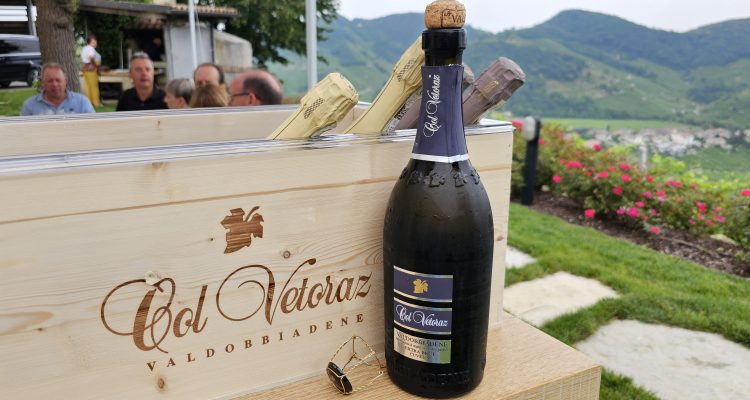Francesco Miotto produces Prosecco sparkling wine, but you won’t see “Prosecco” on the labels.
You will notice the geographic origin of the wine, “Valdobbiadene,” the quality-designated area 50 miles north of Venice where generations of the Miotto family have nurtured vineyards.
With grapes rooted in his heritage, Miotto called two friends, agronomist Paolo De Bortoli and winemaker Loris Dall’Acqua, to propose a partnership to make the highest quality Prosecco. The trio soon joined forces in 1993 to follow their passion for high quality Prosecco and named the company Col Vetoraz after
Miotto’s heritage homestead to reflect its location on the eponymous hill in Valdobbiadene.
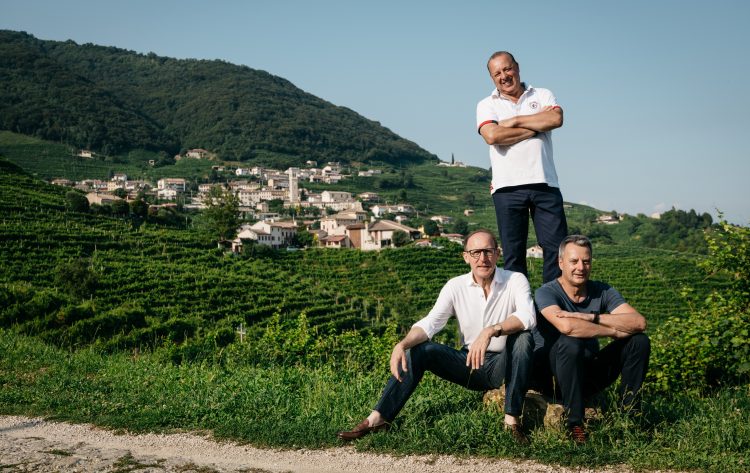
There are reasons why Miotto might follow most of his vintner peers and label his wine as Prosecco. Changes in the Prosecco wine regulations which could elevate or affect Valdobbiadene’s status in the marketplace influenced Miotto to not advertise his wine as Prosecco. After visiting Col Vetoraz, I’ll share reflections on the winery and the wine and food pairings we encountered.
The Valdobbiadene landscape
As the top category of Italian wines, the DOCG designation considers the geography of the land and sets stricter standards for wine quality. Valdobbiadene is located on the hilly, western side of the most renown area for making top quality Conegliano Valdobbiadene Prosecco Superiore in the DOCG wine region.
Tucked into the steep Pre-Alp hills, Col Vetoraz is in the Cartizze subregion of Valdobbiadene. Cartizze is a natural amphitheater which is covered in waves of vineyard slopes known as “hogbacks” for their steep, rolling layers interspersed with valleys.
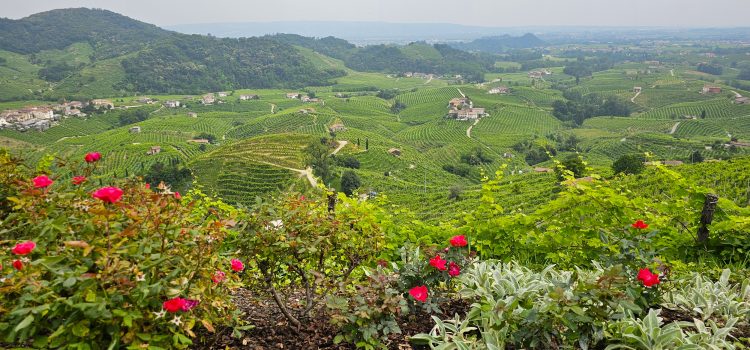
Historic records show that Prosecco grapes have grown in the area since the 1300’s. The Strada del Prosecco of Conegliano Valdobbiadene, the first recognized Italian Wine Road, was officially designated in 1966 before the first consorzio (wine association) in the area was established.
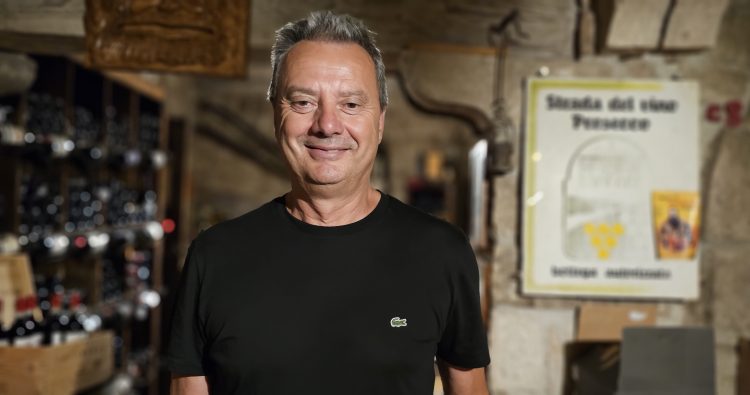
Old stone markers such as the one that I photographed on a previous trip to Cartizze states, “Land, Men, and History of the Cartizze,” honoring the centuries-old tradition of vine growing in Valdobbiadene.
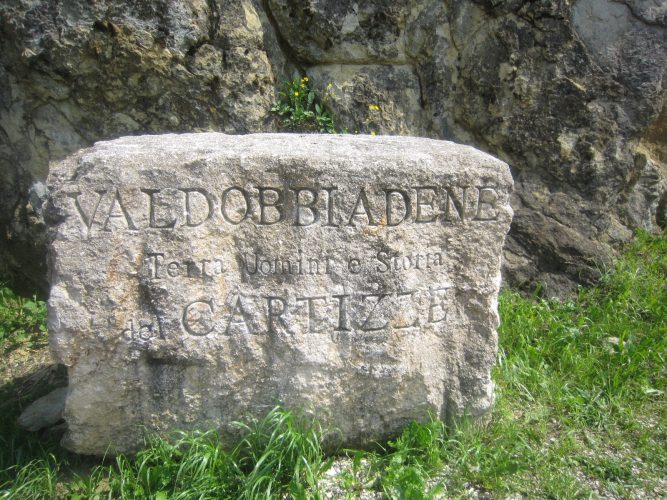
Miotto took over the family’s grape growing business in 1980 when his father died unexpectedly. But selling grapes did not satisfy Francesco Miotto—he wanted to make top quality Prosecco.
With Miotto as president and owner, the energetic Col Vetoraz team quickly made several innovations in the Prosecco category. They released the first vintage Prosecco in 1999 named Millesimato as an ode to Champagne Millesime. The wine soon won several Gran Medaglia d’Oro awards at Vinitaly. Fourteen years later, Col Vetoraz released Extra Brut 0, the first DOCG Superiore without residual sugar. They rebuilt the cellar and opened a modern tasting room nearby. With one million bottles sold annually, the winery is now one of the largest producers of Valdobbiadene DOCG.
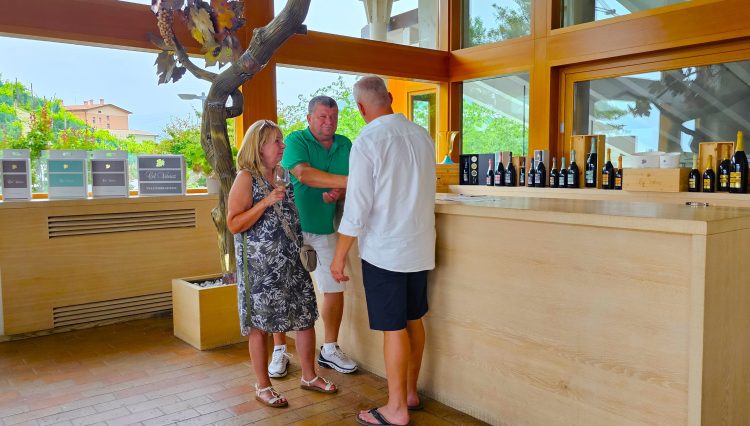
Evolving Wine Regulations
Despite their market success and the industry growth of Prosecco in the U.S., Miotto decided to take Prosecco off the label in 2017. The backstory of this change is related to the history of the Prosecco classification system. In 1969, vintners in the Conegliano Valdobbiadene area successfully received government recognition as a DOC region (denomination of origin) which was regulated by the wine association Consorzio Conegliano Valdobbiadene Prosecco DOC.
In 2009, the Ministry of Agriculture announced major changes to the Prosecco regulations. One new change benefited producers such as Miotto. Wine from the historic hills of Conegliano Valdobbiadene were re-classified as a DOCG territory which is now regulated by the Consorzio Conegliano Valdobbiadene Prosecco Superiore. The changes also included naming the previously called Prosecco grapes with their traditional name of Glera to avoid confusion with the wine Prosecco.
Ristorante Da Gigetto in the province of Treviso near Valdobbiadene proudly displays a banner in their wine cellar indicating Conegliano Valdobbiadene DOCG Prosecco is served at the restaurant. The same Consorzio seal is on each bottle of DOCG wine.
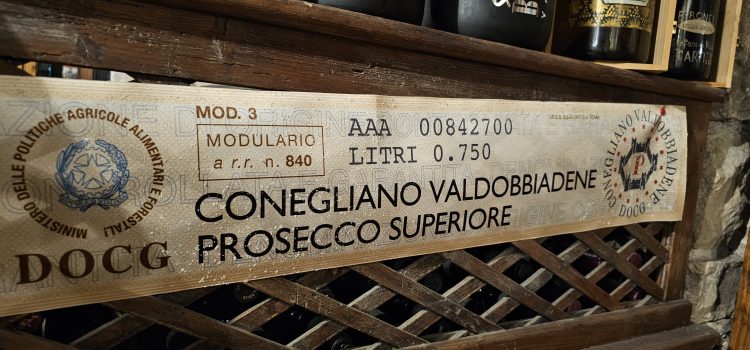
Another significant aspect of the updated regulations alarmed Miotto. A new consorzio was established for Prosecco producers that were located outside the Conegliano Valdobbiadene area named Consorzio Prosecco DOC.
Before the 2009 regulations were set, the previous Conegliano and Valdobiaddene DOC covered 8,700 hectares in the province of Treviso. The new Consorzio Prosecco DOC expanded Prosecco production to 23,000 hectares in nine provinces in the flatlands of the Veneto and Friuli Venezia Giulia regions.
“With Prosecco production allowed throughout much of the lowlands of Northeast Italy, the change made Prosecco a generic consumer name,” said Miotto. The vintner told me the words “Prosecco” and “Prosecco Superiore” are verboten—he speaks only about Valdobbiadene DOCG or Superiore di Cartizze sparkling wine, which he calls the “grand cru” of the area.
A subclassification described in the 2009 changes enabled DOCG Prosecco producers to label their wine as rive, made with grapes grown on the steepest hills in a single hamlet (think single vineyard). Col Vetoraz agronomist Paolo De Bortoli voiced his concern about DOCG Rive Prosecco. “Not all the vineyard blocks in one spot are ‘good.’ We select the best lots.”
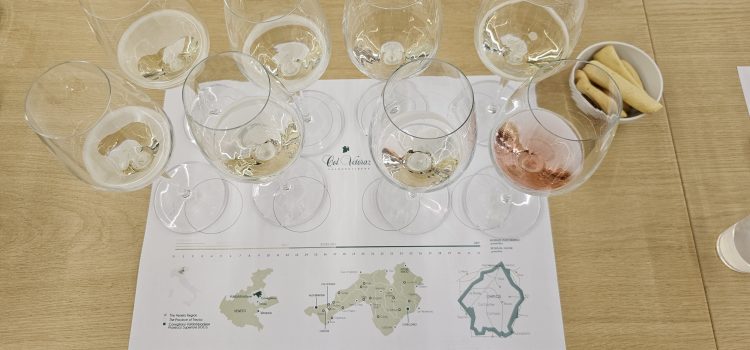
“With sales of Col Vetoraz in 30 countries,” added Export Manager Laura Stocco, “it is difficult enough for people to understand the difference with DOCG Valdobbiadene, let alone rive.”Winemaking at Col Vetoraz
Col Vetoraz produces eight styles of Valdobbiadene DOCG wine with two available in the U.S. in seven states: Valdobbiadene DOCG Superiore di Cartizze and Valdobbiadene DOCG Brut.
Miotto’s mantra is that the wine is made in the vineyards. The grapes are handpicked from the vineyards of 72 growers and the 20 hectares the winery owns.
De Bortoli pays close attention to the grape-growing with support from Miotto’s son Daniele and daughter Francesca on various aspects of the viticulture programs. “Each hill and slope must be cared for individually. The Valdobbiadene clay-limestone soils mixed with marl, mild weather due to protection from the mountains to the north, and diurnal temperature changes add up to excellent Glera grapes,” said De Bortoli.
Designed with a close eye on quality, the Col Vetoraz production cellar at 1,300 feet is the highest in Valdobbiadene. “We have six small presses and ferment each vineyard block separately. After the first fermentation, we keep about 75 percent of the best base wine and sell the rest,” said Dall’Acqua. Miotto joins Dall’Acqua and De Bortoli in blending the wine from the top lots.
One of Dall’Acqua’s techniques leads to rounded and pleasing texture on the palate of their Vadlobbiadene DOCG. “We keep the wine on lees (spent yeast) for a long time. The colloidal protein of the glera grape juice during fermentation leads to smaller, softer bubbles. Many Prosecco wine bubbles are larger and rise vertically to almost hurt your mouth,” said Dall’Acqua.
Col Vetoraz wines and food pairing
The Col Vetoraz wine tasting that made the biggest impression on me occurred during our visit to Cortina d’Ampezzo. A two-hour drive from the winery, Cortina is the skiing location for the 2026 Milan Olympics, at the northwestern edge of the Veneto in the Dolomites.
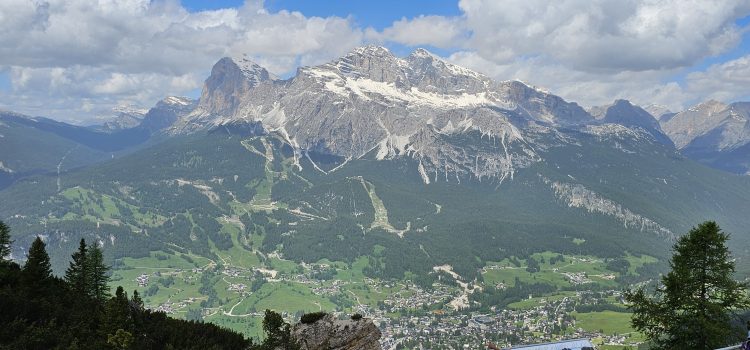
At Cortina, we rode the cable car to Faloria Cristallo mountain where we met Maurizio Barcella, Brand Ambassador for Caviar Giaveri for lunch.
With bubbles and caviar set as a classic pairing, Caviar Giaveri chose Col Vetoraz as their partner at tastings around the world. Barcella led us through a tasting of four of their top tier Italian caviars while Dall’Acqua shared his selection of wines. We learned that Italy is the second largest global producer of high-quality caviar and that Caviar Giaveri is a fine match with Col Vetoraz bubbles.
The last and most expensive caviar, Golden Sterlet gold beads from albino sturgeon, had rich, velvety texture with salty notes. After tasting it with Valdobbiadene DOCG Superiore di Cartizze, I found that the wine and caviar highlighted the best flavors of each.
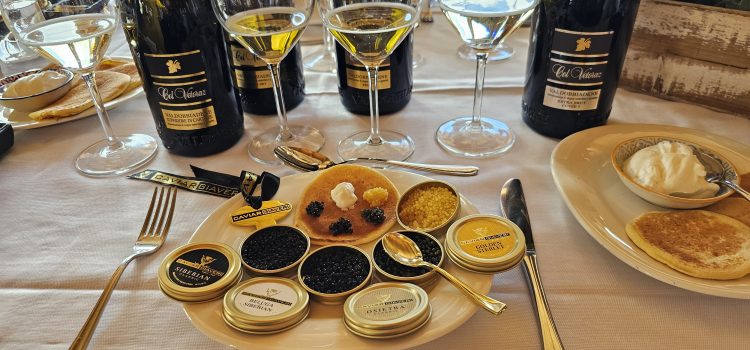
On the way back to Valdobbiadene, we stopped at Ristorante Da Gigetto in Miane, also in Treviso province. As we enjoyed aperitivos in the wine cellar, I chatted with Daniele Miotto and his wife who are excited about the future of Col Vetoraz and their Valdobbiadene DOCG wines.
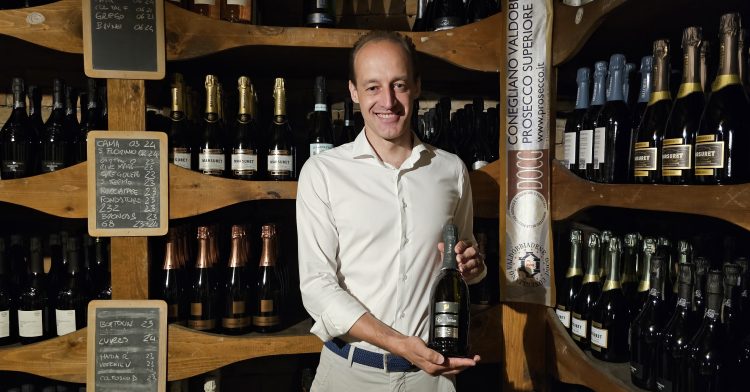
Every course was a revelation with the bubbles. The swordfish was artistically presented with an edible fish garnish.
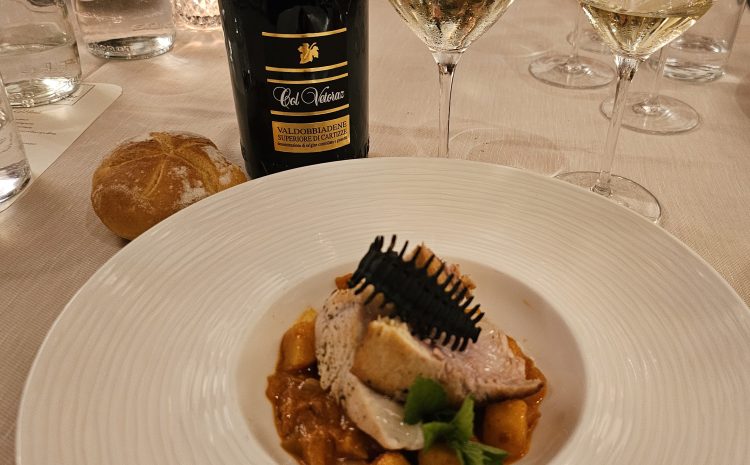
After dining at several venues with Col Vetoraz paired with each course, I am ready to regularly serve bubbles with dessert. At Da Gigetto, the yogurt timbale topped with fresh fruit was a delightful pairing with the Superiore di Cartizze.
In 2019 the Prosecco Hills of Conegliano Valdobbiadene became a UNESCO World Heritage Site to honor the area’s preservation of its cultural landscape. Col Vetoraz continues the traditions set generations ago for growing Glera grapes and making wine in the Valdobbiadene hills. Miotto, De Bortoli and Dall’Acqua are guardians of quality DOCG Prosecco even if the word doesn’t show on the label.
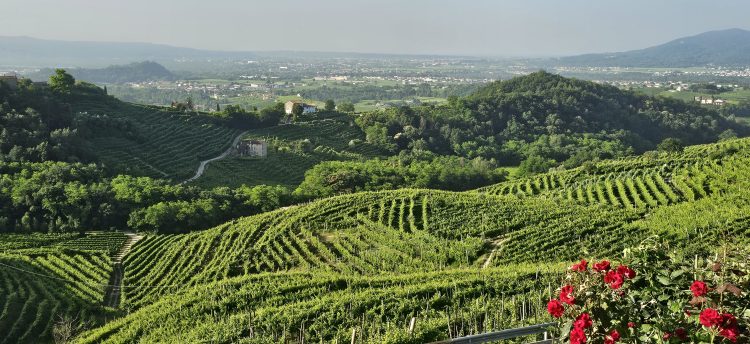
Photos by the author except where noted

